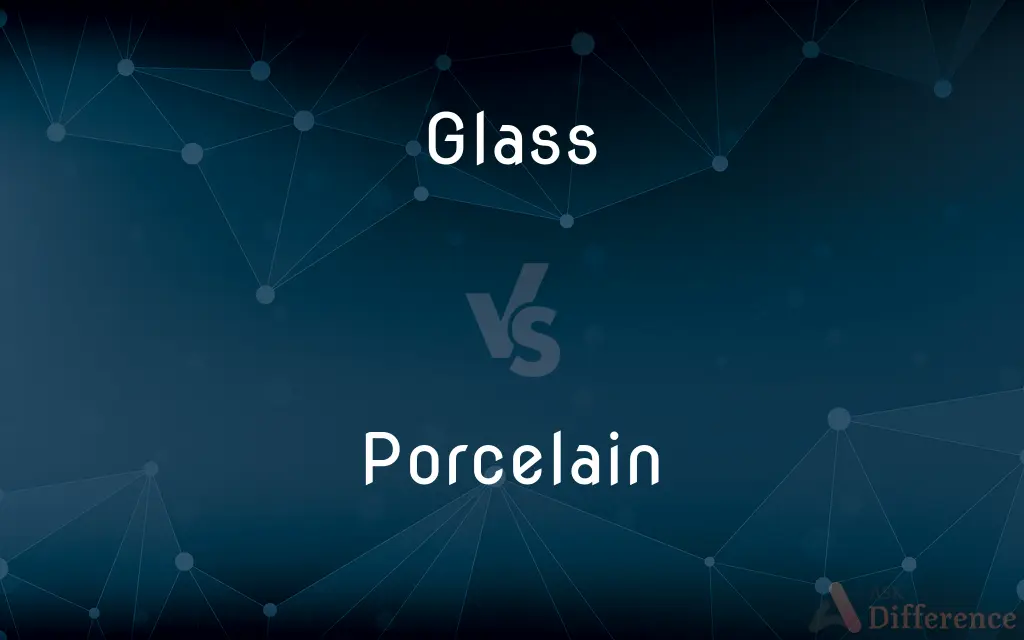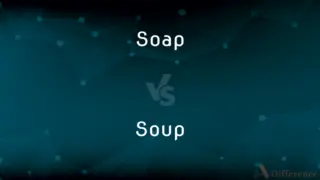Glass vs. Porcelain — What's the Difference?
Edited by Tayyaba Rehman — By Urooj Arif — Updated on March 4, 2024
Glass is transparent and fragile, often used for windows and bottles, whereas porcelain, a type of ceramic, is opaque and stronger, common in dishware and art.

Difference Between Glass and Porcelain
Table of Contents
ADVERTISEMENT
Key Differences
Glass is a hard, brittle material typically transparent or translucent, made by melting sand with soda and lime. It's widely used in items like windows, bottles, and decorative objects. Glass's transparency makes it ideal for applications where light transmission is desired. On the other hand, porcelain is a type of ceramic, made from a refined clay and fired at high temperatures to achieve a dense, vitrified, and often white or delicately colored finish. It's known for its strength, durability, and elegant appearance, making it a popular choice for tableware, tiles, and decorative objects.
While glass can be recycled by melting and reforming, its composition and color can be altered with different additives, leading to a wide range of types including soda-lime glass, borosilicate glass, and lead glass, each with distinct properties and uses. Porcelain, however, is less recyclable due to its high firing temperature, which makes it more energy-intensive to produce. Yet, its superior durability and resistance to chemical and thermal shock make it a more permanent fixture in homes and industries.
Glass is generally more fragile than porcelain, with a tendency to shatter upon impact. This makes glass items more susceptible to damage, requiring careful handling and storage. Porcelain, while also breakable, typically withstands greater forces before breaking, attributed to its denser and more vitrified structure. This resilience is particularly valued in tableware and tiles that endure regular use and cleaning.
Glass is a better insulator than most ceramics, including porcelain. This property makes glass an excellent choice for insulating windows and glassware designed to hold hot liquids. Conversely, porcelain's thermal insulation properties, while not as efficient as glass, contribute to its use in high-quality tea sets and electrical insulators, where slow heat transfer is beneficial.
Glass offers a sleek and modern look, with its transparency and ability to be molded into various shapes. It plays a significant role in contemporary architecture and interior design. Porcelain, with its smooth, glossy surface and potential for intricate designs and colors, exudes elegance and tradition, often used in fine art and high-end tableware.
ADVERTISEMENT
Comparison Chart
Composition
Made from sand, soda, and lime
Made from kaolin clay, fired at high temperatures
Transparency
Transparent or translucent
Opaque, often white or delicately colored
Durability
Fragile, breaks easily
Strong, more resistant to chipping and cracking
Thermal Insulation
Better insulator, used in windows
Lesser insulation, used in tea sets and insulators
Aesthetic
Sleek, modern, versatile in design
Elegant, traditional, allows for intricate designs
Compare with Definitions
Glass
Allows light to enter while providing a barrier.
The glass windows in the office building were designed to be energy efficient.
Porcelain
Popular for its durability and aesthetic appeal.
Their wedding registry included a set of fine porcelain dishes.
Glass
Glass can be recycled by melting and reshaping.
They collected the bottles for glass recycling every Thursday.
Porcelain
Resists thermal shock, making it ideal for certain applications.
Porcelain tiles are chosen for their durability and resistance to heat.
Glass
Known for its brittleness and susceptibility to breakage.
The glass cup shattered into pieces when it hit the floor.
Porcelain
Used for decorative items due to its fine quality.
The museum's collection included a rare porcelain sculpture from the 18th century.
Glass
A transparent material made by melting sand with soda and lime.
The artist molded the molten glass into a beautiful vase.
Porcelain
While strong, can still break under enough force.
The porcelain plate cracked when it was dropped on the tile floor.
Glass
Acts as a good insulator in various applications.
The glass wool insulation in the attic helps keep the house warm in winter.
Porcelain
A type of ceramic made by firing refined clay at high temperatures.
The porcelain vase was decorated with intricate patterns and glazes.
Glass
Glass is a non-crystalline, often transparent amorphous solid, that has widespread practical, technological, and decorative use in, for example, window panes, tableware, and optics. Glass is most often formed by rapid cooling (quenching) of the molten form; some glasses such as volcanic glass are naturally occurring.
Porcelain
Porcelain () is a ceramic material made by heating materials, generally including a material like kaolin, in a kiln to temperatures between 1,200 and 1,400 °C (2,200 and 2,600 °F). The strength, and translucence of porcelain, relative to other types of pottery, arises mainly from vitrification and the formation of the mineral mullite within the body at these high temperatures.
Glass
A hard, brittle substance, typically transparent or translucent, made by fusing sand with soda and lime and cooling rapidly. It is used to make windows, drinking containers, and other articles
The screen is made from glass
A glass door
Porcelain
A hard, white, translucent ceramic made by firing a pure clay and then glazing it with variously colored fusible materials; china.
Glass
A drinking container made from glass
A beer glass
Porcelain
A hard white translucent ceramic, originally made by firing kaolin, quartz, and feldspar at high temperatures but now also inclusive of similar artificial materials; also often (figurative) such a material as a symbol of the fragility, elegance, etc. traditionally associated with porcelain goods.
Tableware and toilets are both made of porcelain.
Glass
Cover or enclose with glass
The inn has a long gallery, now glassed in
Porcelain
A fine translucent or semitransculent kind of earthenware, made first in China and Japan, but now also in Europe and America; - called also China, or China ware.
Porcelain, by being pure, is apt to break.
Glass
Any of a large class of materials with highly variable mechanical and optical properties that solidify from the molten state without crystallization, are typically made by silicates fusing with boric oxide, aluminum oxide, or phosphorus pentoxide, are generally hard, brittle, and transparent or translucent, and are considered to be supercooled liquids rather than true solids.
Glass
Enclose with glass;
Glass in a porch
Glass
Put in a glass container
Common Curiosities
Can glass be recycled?
Yes, glass can be recycled by melting and reshaping it.
Is porcelain recyclable?
Porcelain recycling is less common due to its high firing temperature and durability.
What is the significance of the firing temperature for porcelain?
The high firing temperature vitrifies the porcelain, making it strong and durable.
What is glass made of?
Glass is made from sand, soda, and lime melted together.
How is porcelain produced?
Porcelain is produced by firing refined clay at high temperatures.
Why is glass used in windows?
Glass is used in windows for its transparency and insulation properties.
Can porcelain be used for insulation?
Porcelain is used in electrical insulators, but it's less effective than glass for thermal insulation.
How do the thermal properties of glass and porcelain differ?
Glass is a better insulator, whereas porcelain has lesser insulation properties.
Are there different types of glass?
Yes, including soda-lime glass, borosilicate glass, and lead glass.
Which is more fragile, glass or porcelain?
Glass is generally more fragile than porcelain.
What are the aesthetic differences between glass and porcelain?
Glass offers a modern look; porcelain is elegant and allows for intricate designs.
Why might someone choose porcelain over glass for certain items?
For its durability, aesthetic qualities, and resistance to chipping and cracking.
What makes porcelain a popular choice for tableware?
Its durability, aesthetic appeal, and resistance to thermal shock make it popular.
Can both glass and porcelain be used in art?
Yes, both are used in art for their unique qualities and aesthetic potential.
How does the composition of glass affect its properties?
The composition can alter its color, transparency, and thermal resistance.
Share Your Discovery

Previous Comparison
Guideline vs. Guidance
Next Comparison
Soap vs. SoupAuthor Spotlight
Written by
Urooj ArifUrooj is a skilled content writer at Ask Difference, known for her exceptional ability to simplify complex topics into engaging and informative content. With a passion for research and a flair for clear, concise writing, she consistently delivers articles that resonate with our diverse audience.
Edited by
Tayyaba RehmanTayyaba Rehman is a distinguished writer, currently serving as a primary contributor to askdifference.com. As a researcher in semantics and etymology, Tayyaba's passion for the complexity of languages and their distinctions has found a perfect home on the platform. Tayyaba delves into the intricacies of language, distinguishing between commonly confused words and phrases, thereby providing clarity for readers worldwide.
















































